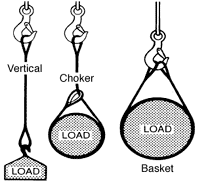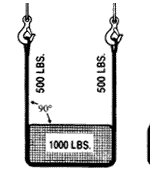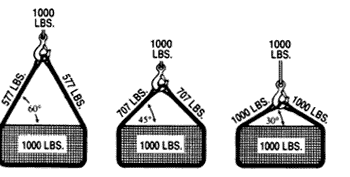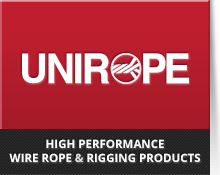General Information on the use of Wire Rope Slings
Some Things Every User Should Know About Use and Care of Wire Rope Slings

EVERY LIFT USES 1 OF 3 BASIC HITCHES:
Vertical, or straight, attachment is simply using a sling to connect a lifting hook or other device to a load. Full rated load of the sling may be used, but never exceeded. A tagline should be used on such a lift to prevent rotation which can damage the sling.
A sling with a hand-tucked splice may unlay and fail if the sling is allowed to rotate.
Choker hitches reduce lifting capacity of a sling, since this method of rigging affects the ability of the wire rope components to adjust during the lift, places angular loading on the body of the sling, and creates a small diameter bend in the sling at the choke point.
Basket hitches distribute the load equally between the two legs of a sling, within limitations imposed by the angles at which legs are rigged to the load (see discussion of sling angles).
Basic Factors concerning the use of Wire Rope Slings
- RATED CAPACITY (Rated Load, WLL) of a wire rope sling is based upon the Nominal Breaking Strength of the wire rope used in the sling, AND FACTORS which affect the overall strength of a sling. These factors include ATTACHMENT or SPLICING EFFICIENCY, the number of parts of rope in the sling, type of hitch (see above), DIAMETER AROUND WHICH THE BODY OF THE SLING IS BENT, and the diameter of pin (or hook) over which the eye of the sling is rigged.
- RATED CAPACITY of a sling is different for each of the three basic methods of rigging (see above). These rated loads are listed in this catalogue. The RATED CAPACITIES apply to UNIROPE slings ONLY and may be indicated on optional tags (if requested).
- WARNING: A hand tucked (hand spliced) eye sling can unlay (unravel) and FAIL if the sling is allowed to rotate during use.
- NEVER “SHOCK LOAD” a sling. There is no practical way to estimate the actual force applied by shock loading. The rated capacity of a wire rope sling can easily be exceeded by a sudden application of force, and damage can occur to the sling. The sudden release of a load can also damage a sling.
- The BODY of a wire rope sling should be protected with corner protectors, blocking or padding against damage by sharp edges or corners of a load being lifted. Sharp bends that distort the sling body damage the wire rope and reduce its strength.
- ANY ANGLE other than vertical at which the sling is rigged, increases the loading (tension) on the sling.
-
A sling should be given a VISUAL INSPECTION BEFORE EACH LIFT OR USAGE to determine if it is capable of safely making the intended lift.
An inspection should include such things as:
• Broken wires
• Kinks or distortions of the sling body
• Condition of eyes and splices, and any attachment hardware
• Reduction in diameter of the rope
• Any damage
• Corrosion - Whenever a sling is found to be deficient, the eyes must be cut, or other end attachments or fittings removed to prevent further use, and the sling body discarded.
- A SLING EYE hould never be used over a hook or pin with a body diameter larger than the natural width of the eye. NEVER FORCE AN EYE ONTO A HOOK. The eye should always be used on a hook or pin with AT LEAST THE DIAMETER OF THE ROPE.
Sling Angles affect the Load on the Legs of a Sling
SLING ANGLE (also called Angle of Loading) is the angle measured between a horizontal line and the sling leg or body. This angle is very important and can have a dramatic effect on the rated load of a sling. As illustrated here, when this angle DECREASES, the LOAD ON EACH LEG INCREASES. This principle applies whether one sling is used with legs at an angle in a basket hitch, or for multi-leg bridle slings. Angles less than 30 degrees should not be used.
 |
 |
Click here for a print-friendly Acrobat PDF file (297k)


